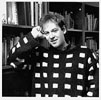 |
 |
 |
note: The late eighties were very productive years for Gerard: in order to accommodate the numbers of works we have divided this aspect of the gallery into several sections, of which this is Lobby. From this Lobby you can read Gerard's text or link to this series painting, drawing or sculpture galleries. To view all the works of eighties "please click here".
| Red
- Blue
- Yellow Works
Lobby |
| Paintings |
Drawings |
Sculptures |
|||
| |
|||||
| ...
please click one of the above images or text to advance to that section
of the gallery .. ... please be patient on page loads these are large galleries ... |
|||||
| Work
that predate or informs Red - Blue - Yellow from the 1970's |
||
| -
The drawing on the left is taken from one of Gerard's first drawing
books 1977. - The black and white image is from the series "Dream Memory of the Brace" 1977. It played a pivotal role in the development of his work - being published worldwide. - The crutch on the right is one of the sculptures from"Voor mij de Realitiet Schommelt" (For me Reality Sways). It was created and exhibited in Amsterdam, 1979. |
||
| sometimes it's difficult to visit our past if it is riddled with pain and consternation but sometimes if we do we can also find resolve, redemption and healing |
||
This
body of work represents one of the most prolific periods in Gerard's
production. Red - Blue Works follow his performance days of the "seventies"
through to his explorations of beauty and truth in the "early
eighties". His "Red - Blue - Yellow" series
combines all of what he learned through the previous years of experience,
providing him with a formidable arsenal in addressing the issues of
the day. It is indeed because of these deep personal experiences that
this body of work is so candidly honest in its simplicity.
The
following comments were first published in the 1987 catalogue "Less
of More - More of Less" and are Gerard's 'Artist Statement.'
This catalogue can be read online here a gerardpas.com by clicking on the details just below. 
Reprinted
from the exhibition catalogue; "Less of More - More of Less (PaS
Plus - PaS Moins)" The
Artists comments "The more man ripens, the more he will become a (creator) and the more he will oppose natural matter and those, who are still dominated by it. He will select his own surroundings and create them. He will therefore not regret the lack of nature, as the masses do, who have been forced in spite of themselves to leave it (......). He will build cities, hygienic and beautiful by a balanced contrast of buildings, constructions and empty space. Then he will be quite as happy indoors as outdoors." Piet Mondriaan The principle
motivation behind this body of work is to present a problematical situation
corresponding directly to one's cognition of reality, and reality's
often relative perception. Gerard Pas - London, Canada. 1987 Other points of interest relating to these works: As stated
in the above text: these works are discussed in length in the following
Catalogue and can be read here at www.gerardpas.com These works
were exhibited extensively around the world. For a summarized list please
read Gerard's biographical data here at www.gerardpas.com. "A
selected Curriculum Vitae, Biography, Resume..." Work from
this series has been included in The
Government of Canada - Canada's Digital Art Collection web site
(this an exceptional web resource on Canada's contemporary art, artists
and their work). These works
were included in the exhibition "Hommage - Demontage" curated
by Dr. Uli Bohnen. Works
from these series have also been included in the following books, both
available in print. |
| Other
points of interest: |
| * Note: "I have included the following links as a pedagogical tool for those who may not know of the art movements, or artists discussed on the pages of Red Blue Yellow Works." Gerard Pas |
| - Learn more about De Stijl or Neoplasticism or Read more on De Stijl from this excellent resource |
| - Learn more about Suprematism |
| - Learn more about Piet Mondrian |
| - Learn more about Kazimir Malevich |
| - Learn more about Gerrit Rietveld |
| - Learn about Rietveld's Schroeder Schräder House |
| - Learn more about Rietveld's Red Blue Chair |
| - Learn more about Theo van Doesburg or See a short film on his works |
| - Learn about J.P.P. Oud designer of Café De Unie |
| - Learn
about Vladimir Tatlin and Constructivism
- or see images from Tatlin's Monument for the Third International |
| - See an example of Otto Freundlich's work as part of MOMA's Provenance Research Project |